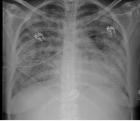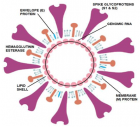Abstract
Literature Review
Prognosis factors for dengue shock syndrome in children
Eka Fitri Sari Ningrum*
Published: 15 October, 2021 | Volume 6 - Issue 1 | Pages: 033-037
Background: Varied clinical manifestations, complex pathogenesis, and different viral serotypes make it difficult to predict the course of dengue disease. Many studies have been conducted on the prognostic factors for the occurrence of dengue shock syndrome (SSD), but all use the 2017 World Health Organization (WHO) guidelines.
Aim: This study aims to determine the prognostic factors for the occurrence of SSD based on WHO guidelines in 2011.
Method: Retrospective study using medical record data of pediatric patients aged 0 to <18 years with a diagnosis of dengue fever dengue (DHF), SSD, and expanded dengue syndrome (EDS) that meet WHO criteria in 2011 at the reputable database from 2017 to December 2020. Independent variables, namely gender, age, nutritional status, secondary dengue infection, leukopenia, abdominal pain, gastrointestinal bleeding, hepatomegaly, and plasma leakage. Shock is the dependent variable. Multivariate analysis using logistic regression analysis.
Results: Subjects who met the study criteria were 145 patients, 52 (35.8%) of whom had SSD. Five of 52 SSD patients went into shock during hospitalization. The bivariate analysis yielded significant factors including, malnutrition, overnutrition and obesity, gastrointestinal bleeding, hemoconcentration, ascites, leukocytes 5,000 mm 3, encephalopathy, enzyme elevation heart, and overload. The results of multivariate analysis showed that hemoconcentration variables and elevated liver enzymes were factors of SSD Prognosis.
Conclusion: Hemoconcentration and elevated liver enzymes are prognostic factors for SSD.
Read Full Article HTML DOI: 10.29328/journal.jcicm.1001039 Cite this Article Read Full Article PDF
Keywords:
SSD; Prognosis; Children
References
- Raihan, Hadinegoro SR, Tumbelaka AR. Prognostic factors shock in dengue hemorrhagic fever. Sari Pediatrics. 2010; 12: 47-52.
- Pawitan JA. Dengue virus infection: predictors for severe dengue. Acta Med Indonesia. 2011; 43: 129-135. PubMed: https://pubmed.ncbi.nlm.nih.gov/21785176/
- Hadinegoro SR, Moedjito I, Chairulfatah A, editors. Guidelines for the diagnosis and management of dengue virus infection in child. Jakarta: IDAI Publishing Agency. 2014; 1-6.
- Huy NT, Van Giang T, Thuy DH, Kikuchi M, Hien TT, et al. Factors associated with dengue shock syndrome: a systematic review and meta-analysis. Plos Negl Trop. 2013; 7: 1-13. PubMed: https://pubmed.ncbi.nlm.nih.gov/24086778/
- Tantracheewathorn T, Tantracheewathorn S. Risk factors of dengue shock syndrome in children. J Med Assoc Thai. 2007; 90: 272-277. PubMed: https://pubmed.ncbi.nlm.nih.gov/17375631/
- Pongpan S, Wisitwong A, Tawichasri C, Patumanond J. Prognostic indicators for dengue infection severity. Int J Clin Pediatr. 2013; 2: 12-18.
- Gupta V, Yadav TP, Pandey RM, Singh A, Gupta M, et al. Risk factors of dengue shock syndrome in children. J Trop Pediatr. 2011; 57: 451-456. PubMed: https://pubmed.ncbi.nlm.nih.gov/21367851/
- Kan EF, Slim TH. Factors associated with shock in children with dengue hemorrhagic fever. Indonesian Pediatrics. 2004; 44: 171-175.
- Dewi R, Tumbelaka AR, Syarif DR. Clinical features of dengue hemorrhagic fever and risk factors of shock event. Pediatrics Indonesia. 2006; 46: 144-148.
- Pham TB, Nguyen TH, Vu TQ, Nguyen TL, Malvy D. Predictive factors of dengue shock syndrome in children hospital no. 1 Ho-chi-Minh City, Vietnam. Bull Soc Pathol Exot. 2007; 100: 43-47. PubMed: https://pubmed.ncbi.nlm.nih.gov/17402695/
- Junia J, Garna H, Setiabudi D. Clinical risk factors for dengue shock syndrome in children. Paediatr Indonesia. 2007; 47: 7-11.
- Widiyati MMT, Laksanawati IS, Prawirohartono EP. Obesity as a risk factor for dengue shock syndrome in children. Pediatrician Indonesia. 2013; 53: 187-192.
- The relationship between clinical and laboratory features as risk factors for shock in dengue hemorrhagic fever. Sari Pediatrics. 2010; 11: 367-373.
- World Health Organization. Comprehensive guidelines for prevention and control of dengue and dengue hemorrhagic fever: revised and expanded edition. New Delhi: South East Asian Region Office-World Health Organization. 2011; 17.
- Kadam DB, Salvi S, Chandanwale A. Expanded dengue. J Assoc Physician India. 2016; 64: 59-63. PubMed: https://pubmed.ncbi.nlm.nih.gov/27759344/
- Pediatric nutritional care. Departmental clinical practice guide RSCM pediatrics. Jakarta. RSCM; 2015; 306-309.
- Boamah L, Balistreri WF. Manifestations of liver disease. In: Behrman RE, Kliegman RM, Arvin AM, editors. Nelson textbook of pediatrics. 18th edition. Philadelphia: WB Saunders. 2007; 1662.
- Matondang CS, Wahidiyat I, Sastroasmoro S. Abdomen. In: Matondang CS, Wahidiyat I, Sastroasmoro S, editor. Physical diagnosis in children. 2nd Edition. Jakarta: Sagung Seto. 2000; 103.
- Soedarmo SS, Garna H, Hadinegoro S, Satari H. Virus infection dengue. In: Soedarmo SS, Garna H, Hadinegoro S, Satari Hi, editor. Textbook of tropical infections and pediatrics. Edition 2nd. Jakarta: IDAI Publishing Agency. 2008. pp.155-81.
- Dengue virus infection. Science department clinical practice guide RSCM child health. Jakarta: RSCM. 2015; 167-182.
- Pothapregada S, Kamalakannan B, Thulisingham M. Risk factors for shock in children with dengue fever. Indian J Crit Care Med. 2015; 19: 661-664. PubMed: https://www.ncbi.nlm.nih.gov/pmc/articles/PMC4687175/
- Phubhakdi CB, Hemunkorn M, Thisyakorn Usa, Thisyakorn C. Risk factors influencing severity in pediatric dengue infections. Asian Biomedicine. 2008; 2: 409-413.
- Kalayanarooj S, Nimmanitya S. Is dengue severity related to nutritional status? Southeast Asian J Trop Med Public Health. 2005; 36: 378-384. PubMed: https://pubmed.ncbi.nlm.nih.gov/15916044/
- Halstead SB. Dengue fever/dengue hemorrhagic fever. In: Behrman RE, Kliegman RM, Arvin AM, editors. Nelson textbook of pediatrics. 18th edition. Philadelphia: WB Saunders. 2007; 1005-1007.
- Trang NTH, Long NP, Hue TTM, Hung LP, Trung TD. Association between nutritional status and dengue infection: a systematic review and meta-analysis. BMC Infect Dis. 2016; 16: 172-183. PubMed: https://pubmed.ncbi.nlm.nih.gov/27097934/
- Yulianto A, Laksono IS, Juffrie M. Prognostic factors of degree severity of dengue infection. Sari Pediatrics. 2016; 18: 198-203.
- Ramachandran S, Geral A, Kamall M, Geral R, Roy MP. Changing trends in clinicopathological parameters in dengue with evaluation of predictors of poor outcome in children. Int J Contemp Pediatr. 2016; 3: 1411-1415.
- Risniati Y, Tarigan LH, Emiliana Tjitra E. Leukopenia as predictors of dengue shock syndrome in children with dengue hemorrhagic fever in RSPI. Prof. dr. Sulianti Saroso. Health Res Dev Media. 2011; 21: 96-102.
- 2nd Edition. World Health Organization; 19977. Dengue haemorrhagic fever: diagnosis, treatment, prevention and control.
- Halstead SB. Dengue. 2007; 370: 1644–1652. PubMed: https://pubmed.ncbi.nlm.nih.gov/17993365/
- Halstead SB. Is there an inapparent dengue explosion? Lancet. 1999; 353: 1100–1101. PubMed: https://pubmed.ncbi.nlm.nih.gov/10199378/
- Kurane I. Dengue hemorrhagic fever with special emphasis on immunopathogenesis. Comp Immunol Microbiol Infect Dis. 2007; 30: 329–340. PubMed: https://pubmed.ncbi.nlm.nih.gov/17645944/
- Littaua R, Kurane I, Ennis FA. Human IgG Fc receptor II mediates antibody-dependent enhancement of dengue virus infection. J Immunol. 1990; 144: 3183-3186. PubMed: https://pubmed.ncbi.nlm.nih.gov/2139079/
- Mady BJ, Erbe DV, Kurane I, Fanger MW, Ennis FA. Antibody-dependent enhancement of dengue virus infection mediated by bispecific antibodies against cell surface molecules other than Fc gamma receptors. Antibody-dependent enhancement of dengue virus infection mediated by bispecific antibodies against cell surface molecules other than Fc gamma receptors. 1991; 147: 3139–3144. PubMed: https://pubmed.ncbi.nlm.nih.gov/1680925/
- Halstead SB, Venkateshan CN, Gentry MK, Larsen LK. Heterogeneity of infection enhancement of dengue 2 strains by monoclonal antibodies. J Immunol. 1984; 132: 1529–1532. PubMed: https://pubmed.ncbi.nlm.nih.gov/6607288/
- Morens DM. Antibody-dependent enhancement of infection and the pathogenesis of viral disease. Clin Infect Dis. 1994; 19: 500–512. PubMed: https://pubmed.ncbi.nlm.nih.gov/7811870/
- Basu A, Chaturvedi UC. Vascular endothelium: the battlefield of dengue viruses. FEMS Immunol Med Microbiol. 2008; 53: 287–299. PubMed: https://pubmed.ncbi.nlm.nih.gov/18522648/
- Chaturvedi UC, Agarwal R, Elbishbishi EA, Mustafa AS. Cytokine cascade in dengue hemorrhagic fever: implications for pathogenesis. FEMS Immunol Med Microbiol. 2000; 28: 183–188. PubMed: https://pubmed.ncbi.nlm.nih.gov/10865168/
- Green S, Rothman A. Immunopathological mechanisms in dengue and dengue hemorrhagic fever. Curr Opin Infect Dis. 2006; 19: 429–436. PubMed: https://pubmed.ncbi.nlm.nih.gov/16940865/
- Anderson R, Wang S, Osiowy C, Issekutz AC. Activation of endothelial cells via antibody-enhanced dengue virus infection of peripheral blood monocytes. J Virol. 1997; 71: 4226–4232. PubMed: https://pubmed.ncbi.nlm.nih.gov/9151809/
- Green S, Rothman A. Immunopathological mechanisms in dengue and dengue hemorrhagic fever. Curr Opin Infect Dis. 2006; 19: 429–36. PubMed: https://pubmed.ncbi.nlm.nih.gov/16940865/
- King CA, Anderson R, Marshall JS. Dengue virus selectively induces human mast cell chemokine production. J Virol. 2002; 76: 8408–8419. PubMed: https://pubmed.ncbi.nlm.nih.gov/12134044/
- Kurane I, Meager A, Ennis FA. Induction of interferon alpha and gamma from human lymphocytes by dengue virus-infected cells. J Gen Virol. 1986; 67: 1653–1661. PubMed: https://pubmed.ncbi.nlm.nih.gov/3116147/
- Kurane I, Innis BL, Nimmannitya S, Nisalak A, Meager A, et al. High levels of interferon alpha in the sera of children with dengue virus infection. Am J Trop Med Hyg. 1993; 48: 222–229. PubMed: https://pubmed.ncbi.nlm.nih.gov/8447527/
- Vitarana T, de Silva H, Withana N, Gunasekera C. Elevated tumour necrosis factor in dengue fever and dengue haemorrhagic fever. Ceylon Med J. 1991; 36: 63–65. PubMed: https://pubmed.ncbi.nlm.nih.gov/1913986/
- Guzmán MG, Kouri G, Bravo J, Valdes L, Vazquez S, Halstead SB, et al. Effect of age on outcome of secondary dengue 2 infections. Int J Infect Dis. 2002; 6: 118–124. PubMed: https://pubmed.ncbi.nlm.nih.gov/12121599/
- Guzmán MG, Kourí G. Dengue: an update. Lancet Infect Dis. 2002; 2: 33–42. PubMed: https://pubmed.ncbi.nlm.nih.gov/11892494/
- Malavige GN, Velathanthiri VG, Wijewickrama ES, Fernando S, Jayaratne SD, et al. Patterns of disease among adults hospitalized with dengue infections. 2006; 99: 299–305. PubMed: https://pubmed.ncbi.nlm.nih.gov/16603571/
- Kabra SK, Jain Y, Pandey RM, Madhulika, Singhal T, et al. Dengue haemorrhagic fever in children in the 1996 Delhi epidemic. Trans R Soc Trop Med Hyg. 1999; 93: 294–298. PubMed: https://pubmed.ncbi.nlm.nih.gov/10492762/
- Bravo JR, Guzmán MG, Kouri GP. Why dengue haemorrhagic fever in Cuba? 1. Individual risk factors for dengue haemorrhagic fever/dengue shock syndrome (DHF/DSS) Trans R Soc Trop Med Hyg. 1987; 81: 816–820. PubMed: https://pubmed.ncbi.nlm.nih.gov/3450004/
- Cunha RV, Schatzmayr HG, Miagostovich MP, Barbosa AM, Paiva FG, et al. Dengue epidemic in the State of Rio Grande do Norte, Brazil, in 1997. Trans R Soc Trop Med Hyg. 1999; 93: 247–249. PubMed: https://pubmed.ncbi.nlm.nih.gov/10492750/
- Thisyakorn U, Nimmannitya S. Nutritional status of children with dengue hemorrhagic fever. Clin Infect Dis. 1993; 16: 295–297. PubMed: https://pubmed.ncbi.nlm.nih.gov/8443312/
- Guzmán MG, Kouri GP, Bravo J, Soler M, Vazquez S, et al. Dengue hemorrhagic fever in Cuba, 1981: a retrospective seroepidemiologic study. Am J Trop Med Hyg. 1990; 42: 179–184. PubMed: https://pubmed.ncbi.nlm.nih.gov/2316788/
- Halstead SB, Streit TG, Lafontant JG, Putvatana R, Russell K, et al. Haiti: absence of dengue hemorrhagic fever despite hyperendemic dengue virus transmission. Am J Trop Med Hyg. 2001; 65: 180–183. PubMed: https://pubmed.ncbi.nlm.nih.gov/11561700/
- Loke H, Bethell DB, Phuong CX, Dung M, Schneider J, et al. Strong HLA class I-restricted T cell responses in dengue hemorrhagic fever: a double-edged sword? J Infect Dis. 2001; 184: 1369–1373. PubMed: https://pubmed.ncbi.nlm.nih.gov/11709777/
- Diana M. Korelasi antara trombositopenia dengan hemokonsentrasi sebai faktor predisposisi terjadinya syok pada pasien demam berdarah dengue dewasa di RSUP Dr.Kariadi Semarang. [Artikel Hasil Karya Tulis Ilmiah]. Semarang: Program Pendidikan Sarjana Kedokteran Fakultas Kedokteran Universitas Diponegoro; 2007.
Figures:

Figure 1

Figure 2
Similar Articles
-
Comparative Hemodynamic Evaluation of the LUCAS® Device and Manual Chest Compression in Patients with Out-of-Hospital Cardiac ArrestMirek S,Opprecht N*,Daisey A,Milojevitch E,Soudry- Faure A,Freysz M. Comparative Hemodynamic Evaluation of the LUCAS® Device and Manual Chest Compression in Patients with Out-of-Hospital Cardiac Arrest. . 2017 doi: 10.29328/journal.jcicm.1001005; 2: 016-024
-
Evaluation of unexplained clinical features of hepatic diseases through biopsies among hospitalized children: A cross-sectional study in Lahore, PakistanIbtasam Ahmad,Muhammad Haris,Amnah Javed,Muhammad Azhar*. Evaluation of unexplained clinical features of hepatic diseases through biopsies among hospitalized children: A cross-sectional study in Lahore, Pakistan . . 2018 doi: 10.29328/journal.jcicm.1001013; 3: 013-019
-
Acute pneumonia: Facts and realities against etiological hypotheses and beliefsKlepikov Igor*. Acute pneumonia: Facts and realities against etiological hypotheses and beliefs. . 2019 doi: 10.29328/journal.jcicm.1001019; 4: 010-017
-
Angioarchitectonics of acute pneumoniaKlepikov Igor*. Angioarchitectonics of acute pneumonia. . 2019 doi: 10.29328/journal.jcicm.1001020; 4: 018-022
-
Prognosis factors for dengue shock syndrome in childrenEka Fitri Sari Ningrum*. Prognosis factors for dengue shock syndrome in children. . 2021 doi: 10.29328/journal.jcicm.1001039; 6: 033-037
-
Clinical profile, etiology, outcome and new-onset diabetes: A SARI case seriesSiddharth Agarwal*,Sapna Agarwal,Raj Kumar Verma,Shreyash Dayal. Clinical profile, etiology, outcome and new-onset diabetes: A SARI case series. . 2022 doi: 10.29328/journal.jcicm.1001041; 7: 005-015
Recently Viewed
-
Sinonasal Myxoma Extending into the Orbit in a 4-Year Old: A Case PresentationJulian A Purrinos*, Ramzi Younis. Sinonasal Myxoma Extending into the Orbit in a 4-Year Old: A Case Presentation. Arch Case Rep. 2024: doi: 10.29328/journal.acr.1001099; 8: 075-077
-
Electrocoagulation with greased lidocaine gel 2% as hemostatic maneuver after minimally invasive partial nephrectomy: Experimental and preliminary clinical resultsMarcos Tobias-Machado*,Vinicius JA Panico,Lucila H Simardi,Eliney F Faria,Rene Sotelo,Ruben Suarez,Diego Abreu,Andre Meirelles,Edison Schneider,Hamilton C Zampolli. Electrocoagulation with greased lidocaine gel 2% as hemostatic maneuver after minimally invasive partial nephrectomy: Experimental and preliminary clinical results. Arch Cancer Sci Ther. 2020: doi: 10.29328/journal.acst.1001017; 4: 019-023
-
Squamous Cell Carcinoma of the External Auditory Canal in Previously Treated Case of Adenoid Cystic Carcinoma of Parotid GlandVaishnavi Vasant Kulkarni*,R Srikanth,Sandhya Rani,M Radhika Rani. Squamous Cell Carcinoma of the External Auditory Canal in Previously Treated Case of Adenoid Cystic Carcinoma of Parotid Gland. J Radiol Oncol. 2025: doi: 10.29328/journal.jro.1001081; 9: 054-055
-
Differentiation of the Non-dipping Blood Pressure Phenotype in Obstructive Sleep Apnea: An Observational StudyMatilde Valencia-Flores*,Victoria Santiago-Ayala,Margarita Fernández López,Jorge Oseguera Moguel,Gerardo Payró Ramirez,Montserrat Reséndiz-Garcia,Montserrat Memetla-Argumedo,Gabriela Gaytán-Cervantes,Ramón Morales-Navarro,Carlos A. Aguilar-Salinas,Donald L. Bliwise. Differentiation of the Non-dipping Blood Pressure Phenotype in Obstructive Sleep Apnea: An Observational Study. Ann Clin Hypertens. 2025: doi: 10.29328/journal.ach.1001037; 9: 001-008
-
Physical activity can change the physiological and psychological circumstances during COVID-19 pandemic: A narrative reviewKhashayar Maroufi*. Physical activity can change the physiological and psychological circumstances during COVID-19 pandemic: A narrative review. J Sports Med Ther. 2021: doi: 10.29328/journal.jsmt.1001051; 6: 001-007
Most Viewed
-
Sinonasal Myxoma Extending into the Orbit in a 4-Year Old: A Case PresentationJulian A Purrinos*, Ramzi Younis. Sinonasal Myxoma Extending into the Orbit in a 4-Year Old: A Case Presentation. Arch Case Rep. 2024 doi: 10.29328/journal.acr.1001099; 8: 075-077
-
Evaluation of Biostimulants Based on Recovered Protein Hydrolysates from Animal By-products as Plant Growth EnhancersH Pérez-Aguilar*, M Lacruz-Asaro, F Arán-Ais. Evaluation of Biostimulants Based on Recovered Protein Hydrolysates from Animal By-products as Plant Growth Enhancers. J Plant Sci Phytopathol. 2023 doi: 10.29328/journal.jpsp.1001104; 7: 042-047
-
Feasibility study of magnetic sensing for detecting single-neuron action potentialsDenis Tonini,Kai Wu,Renata Saha,Jian-Ping Wang*. Feasibility study of magnetic sensing for detecting single-neuron action potentials. Ann Biomed Sci Eng. 2022 doi: 10.29328/journal.abse.1001018; 6: 019-029
-
Physical activity can change the physiological and psychological circumstances during COVID-19 pandemic: A narrative reviewKhashayar Maroufi*. Physical activity can change the physiological and psychological circumstances during COVID-19 pandemic: A narrative review. J Sports Med Ther. 2021 doi: 10.29328/journal.jsmt.1001051; 6: 001-007
-
Pediatric Dysgerminoma: Unveiling a Rare Ovarian TumorFaten Limaiem*, Khalil Saffar, Ahmed Halouani. Pediatric Dysgerminoma: Unveiling a Rare Ovarian Tumor. Arch Case Rep. 2024 doi: 10.29328/journal.acr.1001087; 8: 010-013

HSPI: We're glad you're here. Please click "create a new Query" if you are a new visitor to our website and need further information from us.
If you are already a member of our network and need to keep track of any developments regarding a question you have already submitted, click "take me to my Query."
















































































































































